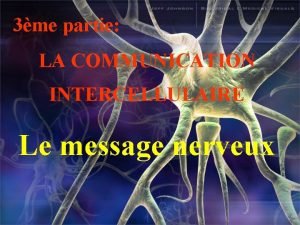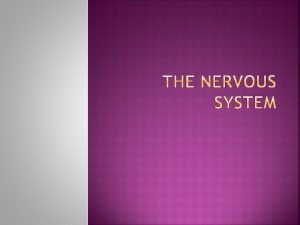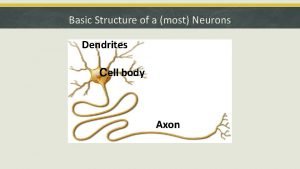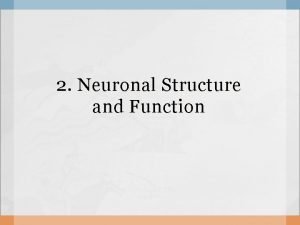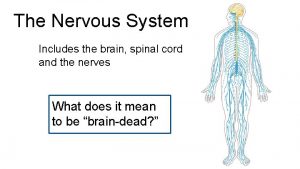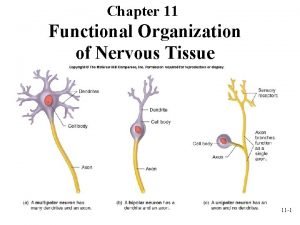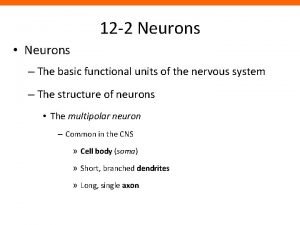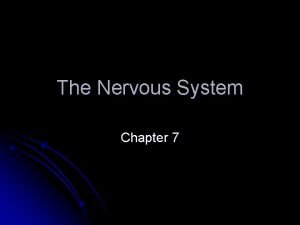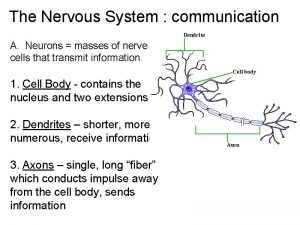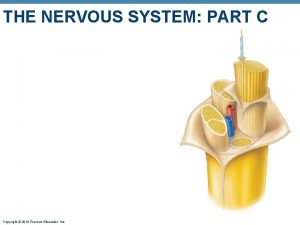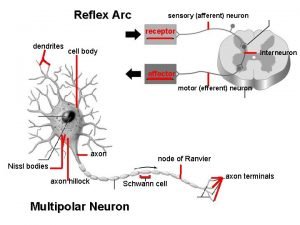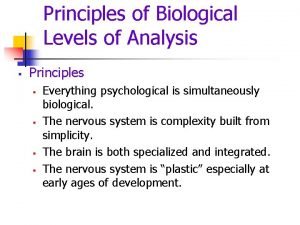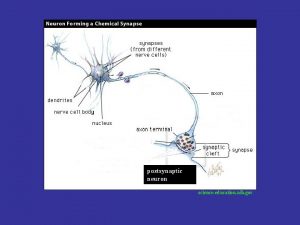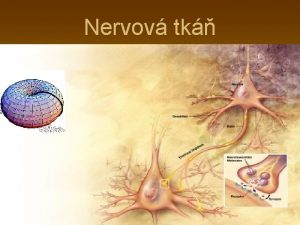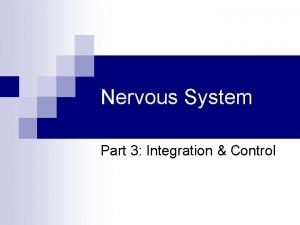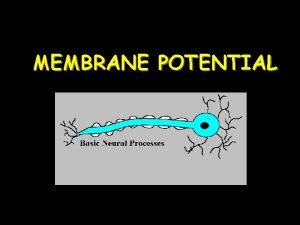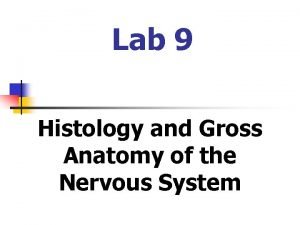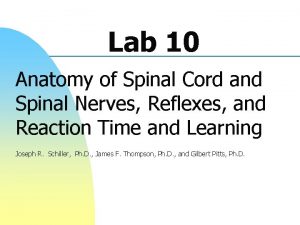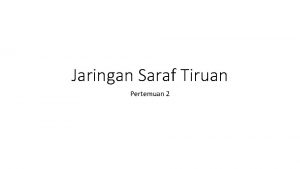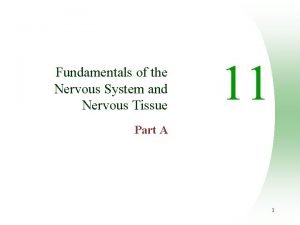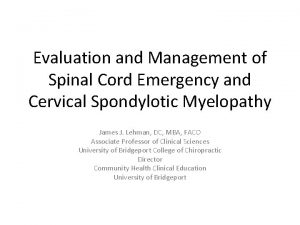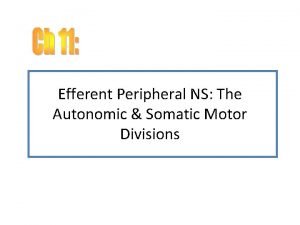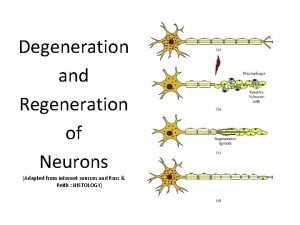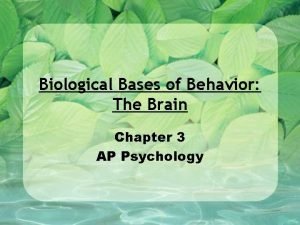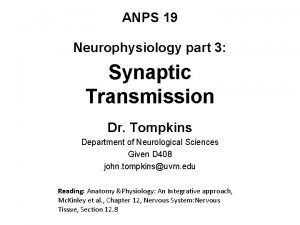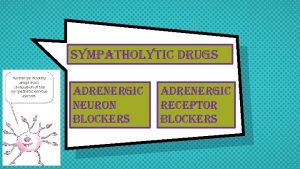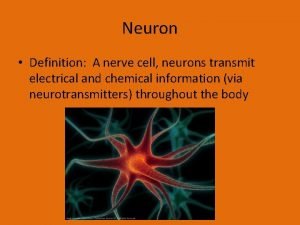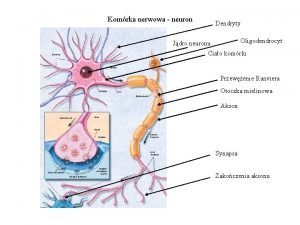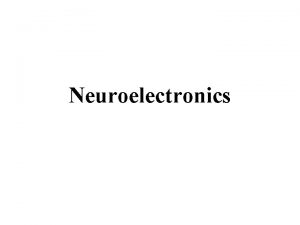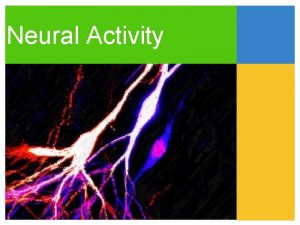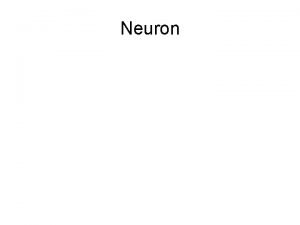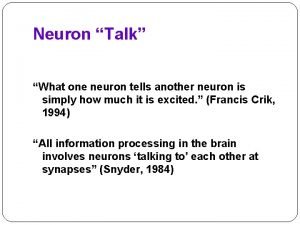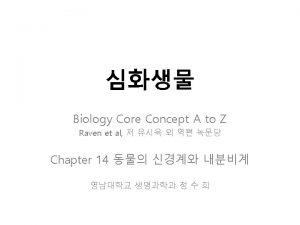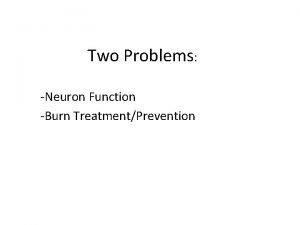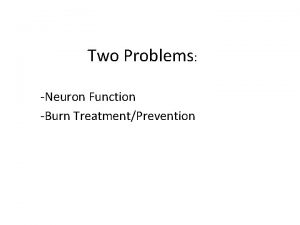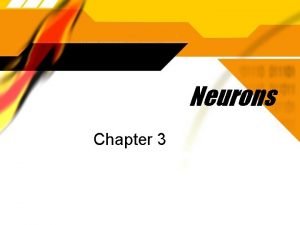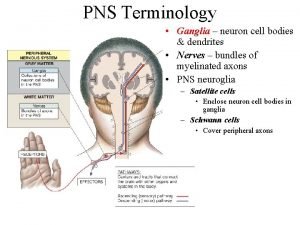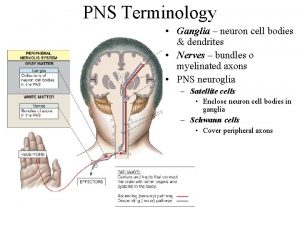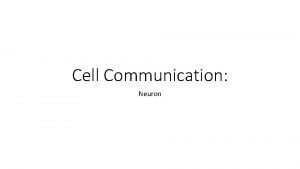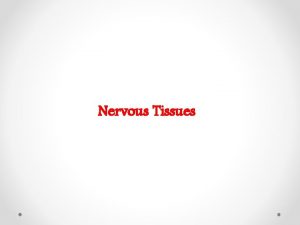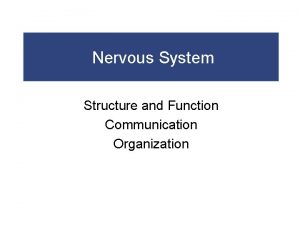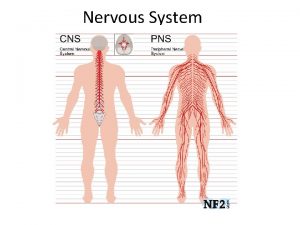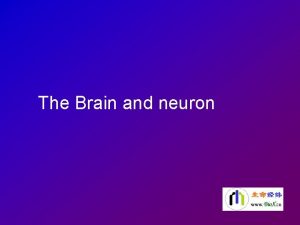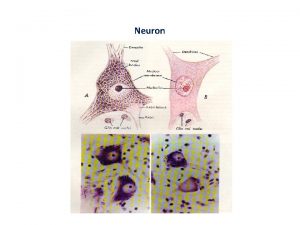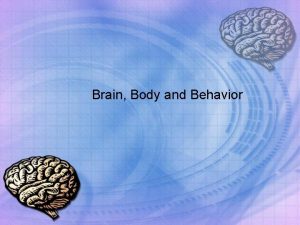STRUCTURE AND FUNCTION NEURON COMMUNICATION REFRESHED Dendrites receive








































- Slides: 40

STRUCTURE AND FUNCTION


NEURON COMMUNICATION REFRESHED • Dendrites receive signals (nerve impulses) from other neurons • Some are inhibitory, others excitatory and the signals are cumulatively collected • If the sum of the potentials crosses the threshold, then an action potential is triggered in the axon hillock, if not, no action potential is triggered • Action potentials are electrical, they are a temporary reversal of the electrical potential of the axon’s membrane, lasting scarcely a few milliseconds.

CONTINUED • When the action potential reaches the terminal button, vesicles containing neurotransmitters bind to the cell wall and release neurotransmitters into the synaptic gap • The neurotransmitters bind to receptor sites on the receiving neuron and either instigate excitatory or inhibitory messages

• Depolarization - Sodium gates open and the axon section becomes positively charged as sodium rushes in • Repolarization – Sodium channels close and potassium gates open and potassium rushes out of the cell and the axon section becomes negatively charged

TWO HEMISPHERES • The two halves of the human brain are not exactly alike but there are pairs of structures • -Left/right

VENTRICLES �Cerebrospinal fluid is contained within the ventricles ◦ CSF: protection, buoyancy, waste clearance and


THE BRAINSTEM: THE OLDEST AND INNER MOST PART OF THE BRAIN • Brain stem is where the spinal cord swells (medulla and pons) • Medulla controls heartbeat and breathing • Pons –‘Bridge’ –Coordinates movement –Involved in sleep, arousal, facial expression • Reticular Formation • this portion of the brain is responsible for mood, arousal and sleep • The neurons here are the source of most serotonin and norepinephrine in the brain

CATS AND THE RETICULAR FORMATION • If you stimulate the reticular formation • …you are almost instantly alert • If you sever it then… • Welcome to your coma from which you will never

THALAMUS & CEREBELLUM STILL CONSIDERED LOWER-LEVEL BRAIN STRUCTURES �Thalamus (thalami plural) ◦ ◦ ◦ Pair of egg shaped structures on top of the brainstem receives information from all of our body’s sensory organs (except smell – olfactory bulb) and reroutes it to higher areas for processing (sight, hearing, taste, touch) The Cortex is very connected to the thalamus – involved in memory and states of consciousness • Cerebellum – who are you really? – We know that it helps coordinate voluntary movement and balance • How do we test for inebriation? – We used to underestimate it but now… – Damage leads to subtle deficits in language, cognition and perception

SUBCORTICAL STRUCTURES: LIMBIC SYSTEM BETWEEN THE OLD STUFF AND THE CEREBRAL HEMISPHERES • Amygdala • Two almond/lima bean shaped clusters • Involved in identifying, remembering and responding to fear and aggression • Hypothalamus • Hippocampus • Pituitary

THE PLACID CAT HAD ITS AMYGDALA STIMULATED • Placement matters • One area can trigger aggression while stimulation of another area can trigger the creature to cower in fear

WHAT IF THE AMYGDALA IS REMOVED FROM A TYPICALLY ILL-TEMPERED CREATURE? • Hello Happy Rhesus Monkey

SUBCORTICAL STRUCTURES: LIMBIC SYSTEM BETWEEN THE OLD STUFF AND THE CEREBRAL HEMISPHERES • Amygdala • Hypothalamus • Monitors and influences hunger, thirst, body temperature and even our sexual behavior • Maintains a steady internal state • 4 F behaviours: feeding, fleeing, fighting and fornicating • Secretes hormones and triggers the pituitary • Hippocampus • Pituitary

SUBCORTICAL STRUCTURES: LIMBIC SYSTEM BETWEEN THE OLD STUFF AND THE CEREBRAL HEMISPHERES • Amygdala • Hypothalamus • Hippocampus • involved in the processing of memory (especially long-term) • Damage here results in profound impairments in forming new memories • Pituitary • A. k. a. The Master Gland Influences hormone release by other glands


CORTEX – LOVE YOUR WRINKLES Grey matter – White matter – not the cortex (like bark) cortex • part of the brain that is • Myelin on the nerve fibers controlled by the (axons) makes it white nerve cell bodies and the majority of the true • Fatty insulators speed dendrites communication – one of • Grey because the the type of glial cells neuronal nuclei and • Glial cells are the glue – somas and dendrites neurons get the attention don’t have fatty myelin but they cannot feed or sheath themselves - glial • Does the real cells do that processing

TWO HEMISPHERES • They are connected by the corpus callosum • A band of axon fibers that transmit messages between the two hemispheres • There is localization of function • The areas of the cerebral cortex fall into three categories: Sensory, motor and Association

LOCALIZATION OF FUNCTION � The areas of the cerebral cortex fall into three categories: Sensory, Motor and Association �Sensory ◦ Processes incoming information from the sensory systems (eg. vision or taste) �Motor ◦ Provides highest level of voluntary control over movement �Association ◦ Helps build bridges between sensation and action, language, and abstract thought

PRACTICE, PRACTICE • Imagine driving a car – think back to a real experience and remember some of the behaviours involved…now explain which parts of the brain are activated with this task

TWO HEMISPHERES REMINDER • They are connected by the corpus callosum • A band of axon fibers that transmit messages between the two hemispheres • Remember that our left hemisphere is responsible for the right side of our body and the right hemisphere is responsible for the left side of our body

LATERALIZATION – TYPICALLY LEFT HEMISPHERE DOMINANT FOR LANGUAGE • Damage to the left hemisphere can impair reading, writing, speaking, arithmetic reasoning, and understanding • Damage to the right had less dramatic effects – but it is not ‘just along for the ride’ • Information received by one hemisphere is quickly shared across the corpus callosum

RIGHT-LEFT DIFFERENCES • Speaking and calculating activity occurs in the left hemisphere • Perceptual tasks are performed in the right hemisphere • The caveat is that the right hemisphere excels in making inferences, modulating speech and orchestrating our sense of self

THE CEREBRAL CORTEX IS DIVIDED INTO FOUR LOBES • Frontal lobe • involved in speaking, muscle movements, thinking and planning • Temporal lobe • includes the auditory areas • Parietal lobe • includes the sensory cortex • Occipital lobe • includes the visual area that receives information from eyes

LATERAL FISSURE CENTRAL SULCUS

SOMETHING COOL… �Motor cortex ◦ Provides highest level of voluntary control over movement ◦ researchers stimulate this section and cause movement of body parts (opposite side of body) � Somatosensory ◦ cortex Receives the incoming messages ◦ If you stimulate a point on top of the top of this band of tissue, the person may report being touched on the shoulder (try the side, feel the face)

SENSORY INFORMATION OTHER THAN TOUCH IS RECEIVED OUTSIDE OF THE SOMATOSENSORY CORTEX �Auditory ◦ Processes information that you hear �Motor ◦ Provides highest level of voluntary control over movement

ASSOCIATION AREAS Association areas of the cortex that are not involved in primary motor or sensory functions They are involved in higher mental functions such as learning, remembering, thinking and speaking Let’s look at reading out loud… How to remember functions of Broca’s area and Wernicke’s area.

BROCA AND WERNICKE • Language areas – Wernicke - comprehension – damage leads to incomprehensible speech • Broca – speech function – damage leads to speech production difficulties • Brainstorm ways to differentiate between them.

REALLY COOL RESEARCH!!!! • Researchers have been able to predict a monkey’s arm movement BEFORE it moved (1/10 second) – they had repeatedly measured motor cortex activity preceding specific arm movements

REALLY COOL RESEARCH!!!! • Researchers have been able to predict a monkey’s arm movement BEFORE it moved (1/10 second) – they had repeatedly measured motor cortex activity preceding specific arm movements • Researchers also had monkeys use a joystick to follow a red target on a screen and then matched the arm movements with brain signals. • A computer was then programmed to monitor the signals and operate the joystick – when the monkey thought about moving the computer moved the cursor with almost the same proficiency as the monkey

BRAIN COMPUTER INTERFACE – SO COOL! RESEARCHERS HAVE STARTED TO BE ABLE TO PREDICT MOVEMENT BEFORE IT OCCURS HTTPS: //WWW. YOUTUBE. COM/WATCH? V=7 T 84 L GE 5 TXA Currently, research is looking at the possibility of brain computer interfaces to facilitate cognitive neural prosthetics


• Some hormones are chemically identical to neurotransmitters but think of the endocrine system as slow and steady as opposed to fast and brief • Key hormones to note are oxytocin, epinephrine (adrenaline) and norepinephrine (noradrenaline) • Hormone messages outlast neurotransmitter effects • Eg the Autonomic Nervous System orders adrenal glands on top of the kidneys to release epinephrine and norepinephrine (increase heart rate, blood pressure, blood sugar, FFF response)

INTERACTION BETWEEN THE NERVOUS AND ENDOCRINE SYSTEM CAN BE SEEN IN THE FIGHT OR FLIGHT MECHANISM AND SEXUALITY • Remember that the hypothalamus monitors blood chemistry and messages from other parts of the cerebral cortex • Signals that you are thinking about sex prompts the hypothalamus to secrete hormones that in turn trigger the pituitary to influence sex glands to release their hormones which in turn intensify thoughts of sex in the cerebral cortex


PRACTICE, PRACTICE • Work on your Concept/mind maps and your handouts


EXPERT GROUPS • Groups of three • • • Understanding the teen brain Law and psychology Autism and motor neurons • How does biopsychology enhance our understanding or expertise as scientists interested in behaviour and mental processes
 The neuron process that normally receive incoming stimuli
The neuron process that normally receive incoming stimuli Dendrites et axones
Dendrites et axones Dendrites
Dendrites Dendrites analogy
Dendrites analogy Dendrites
Dendrites Bipolar neuron function
Bipolar neuron function Where are glial cells located
Where are glial cells located Componentes componentes
Componentes componentes Synaptic potential
Synaptic potential Function of multipolar neuron
Function of multipolar neuron Structure of neuron ppt
Structure of neuron ppt Na+ equilibrium potential
Na+ equilibrium potential Neuroglial cells
Neuroglial cells One motor unit
One motor unit When dealing with a complaint it is vital to remember that
When dealing with a complaint it is vital to remember that Mpi send and receive example
Mpi send and receive example Spinal nerves
Spinal nerves Site of somatic motor neuron cell bodies
Site of somatic motor neuron cell bodies All or none law
All or none law Postsynaptic neuron
Postsynaptic neuron Umnl and lmnl of facial nerve
Umnl and lmnl of facial nerve Convergence neuron
Convergence neuron Nissl substance
Nissl substance Three basic parts of a neuron
Three basic parts of a neuron Quizlet
Quizlet Lower motor neuron lesion
Lower motor neuron lesion Neuron histology
Neuron histology Somatic motor neuron
Somatic motor neuron Buatlah model neuron mcp untuk menyatakan fungsi logika or
Buatlah model neuron mcp untuk menyatakan fungsi logika or Neural circuits the organization of neuronal pools
Neural circuits the organization of neuronal pools Identify each type of neuronal pool
Identify each type of neuronal pool Site of somatic motor neuron cell bodies
Site of somatic motor neuron cell bodies Somatic motor neuron
Somatic motor neuron Neuron sheath
Neuron sheath A neuron without terminal buttons would be unable to
A neuron without terminal buttons would be unable to Neurotransmitter of somatic nervous system
Neurotransmitter of somatic nervous system Distribution of gated channels on a neuron
Distribution of gated channels on a neuron Graded potential
Graded potential Adrenergic neuron blockers
Adrenergic neuron blockers Neuron def
Neuron def Nerwowy
Nerwowy

